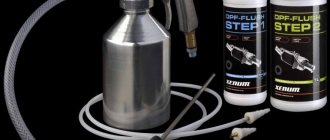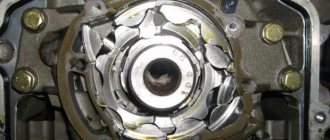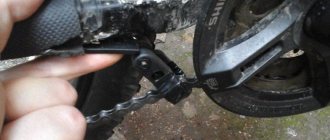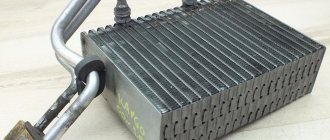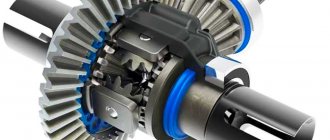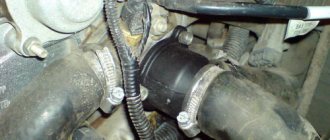Environmental safety standards (Euro 3 and higher) require filtration of exhaust from cars with diesel engines. To meet these standards, car manufacturers use a special device called a particulate filter. In this article we will talk about what a particulate filter is, how it works and how it works.
What is a diesel particulate filter?
During operation of a diesel engine, the corresponding fuel does not burn completely, forming solid particles in the size range between 10 nm and 1 micron.
Solid soot particles are classified as hazard class 3 pollutants. When in contact with the human body, they provoke exacerbation of respiratory diseases and skin cancer, and disrupt climatic conditions in the environment. Thus, rain on weekends in large cities occurs, in particular, due to the fact that water droplets in the atmosphere form around soot particles. The presence of a particulate filter reduces the content of particulate matter in the exhaust by 80-90%. However, this result comes at the cost of technological complexity and high cost of the system. Let's take a closer look at its design and operating principle.
Story
Diesel particulate filtration was first considered in the 1970s due to concerns about exposure to respirable particulate matter.[11] Diesel particulate filters have been used on off-road vehicles since 1980, and in cars since 1985[12][13] Historically, emissions from medium- and heavy-duty diesel engines were not regulated until 1987, when California's first heavy-duty truck rule was implemented, capping particulate emissions at 0.60 g/L.[14] Since then, increasingly stringent standards have been introduced for light and heavy-duty on-road diesel vehicles, as well as for off-road diesel engines. Similar rules have been adopted by the European Union and some individual European countries, most Asian countries and the rest of North and South America.[15]
Although no jurisdiction has made filters mandatory, increasingly stringent emissions standards that engine manufacturers must meet mean that eventually all on-road diesel engines will be equipped with them.[14] In the European Union, filters are expected to be required to meet Euro.VI heavy-duty truck engine emissions regulations currently under discussion and planning for the 2012-2013 period. In 2000, in anticipation of future Euro 5 regulations, PSA Peugeot Citroën became the first company to make filters standard on passenger cars.[16]
As of December 2008, the California Air Resources Board (CARB) established the 2008 California Truck and Bus Regulations which—with variations depending on the type, size, and use of the vehicle—requires that off-road diesel heavy duty trucks and buses in California have been retrofitted, retrofitted or replaced to reduce particulate matter (PM) emissions by at least 85%. One way to meet this requirement is to retrofit engines with CARB-approved diesel particulate filters.[17] In 2009, the American Recovery and Reinvestment Act
provided funding to help owners offset the cost of diesel engine upgrades for their vehicles.[18] Other jurisdictions have also launched modernization programs, including:
- 2001 - Hong Kong modernization program.[19]
- 2002 - In Japan, Tokyo Prefecture passed a law prohibiting trucks without filters from entering the city.[20]
- 2003 - Mexico City launched a truck modernization program.[21]
- 2004 - New York retrofit program (off-road).[22]
- 2008 - Milan Ecopass area traffic charge - high entry tax on all diesel vehicles except those with a particulate filter, either standard or retrofitted.[23]
- 2008 - London Low Emission Zone charges cars that fail to meet emissions standards, encouraging filter upgrades.[24][25]
Improperly maintained particulate filters on diesel vehicles are prone to soot accumulation, which can cause engine problems due to high back pressure.[4]
The UK made changes to its MOT test requirements in 2022.[26] including stricter inspection of diesel vehicles. One of the requirements was to have a properly fitted and functioning particulate filter. Driving without a particulate filter can result in a fine of £1,000.[27][28]
How does a particulate filter work?
There are several types of filter systems:
- DPF (Diesel Particulate Filter)
- FAP (Filter a Particules)
- RPF (RussPartikelFilter)
They have some differences in operating principles.
Thus, FAP and RPF systems require the use of special fuel additives that bind solid particles. This circumstance is associated with a more complex design (the presence of a tank for the additive) and, accordingly, an increased cost of operation due to the need to replenish the additive. DPF filters do not require the use of additives. The average design of a particulate filter includes:
- ECU (electronic control unit).
- Pressure and temperature sensors connected to it at the inlet and outlet of the filter.
- Catalyst block.
- Actually a metal-ceramic filter.
Models designed for the use of fuel additives are also equipped with a tank for storing the liquid used and nozzles for injecting it into the fuel tank or into the space between the catalyst and the filter.
The catalyst and filter are usually equipped with communicating housings. Some models use a special catalytic-coated particulate filter, eliminating the need for a separate catalyst unit.
The operating period of the filter - what does it depend on?
Almost all the leaders of the global automotive industry universally declare that the period of stable operation of a particulate filter ranges from 100-150 thousand km. And no less. And yet such data is hard to believe. After all, such “eco-defenders” have been used for a long time. And practice has clearly proven that the digital data was probably calculated for ideal vehicle operating conditions. But in Russia there are no such conditions, so the cells become clogged much earlier.
The quality of diesel fuel and engine oil has the most negative impact on the particulate filter. It’s more likely not the oil itself, but the additives it contains. The problem with the lubricant is solved quite trivially - the system should be filled with engine oil marked “DPF” or “FAP” on the canister. Unfortunately, nothing can be done about diesel fuel: Russian gas stations often sell fuel with a high sulfur content, which leads to a catastrophic reduction in the working life of the exhaust gas filtration system. So the question arises among car owners whether a particulate filter is needed in principle...
Working principle of the diesel particulate filter
From the engine, exhaust gases enter the exhaust system, pass through a cellular catalyst and enter the particulate filter.
The metal body of this structural element houses a ceramic filter structure with many blind channels, crypts. Soot particles settle on their walls, and the remaining components in a gaseous state continue their path through the exhaust system, passing through the filter material by diffusion. This is the main mode of operation – filtering. DPF regeneration
During operation, the filter crypts quickly become clogged with soot. It would be impractical to change it every 600 - 2000 km, so the filters have regeneration cycles.
The ECU reads the differential pressure and/or temperature at the inlet and outlet of the exhaust system assembly. When the difference in indicators reaches a certain level, the system “realizes” that the filter is clogged and activates the regeneration process. The regeneration process is possible only under certain conditions: required engine temperature (at least 800C), speed (at least 80 km/h), time (from 2 to 15 minutes). If such conditions do not arise, the process of so-called spontaneous regeneration is impossible. This is why the filters of cars that move mainly within the city become clogged faster.
Filter regeneration involves burning off accumulated soot. Depending on the model, this occurs using an electric heating element or by injecting certain amounts of fuel into the exhaust system. During regeneration, the filter heats up to a significant temperature (7000C or more), and therefore is only possible under the conditions indicated above.
There is a forced regeneration procedure, which is performed at special stands in service centers, but due to the high temperatures, it is dangerous to resort to it and not many service centers are ready to do this. It should be noted that filter washing is not an alternative to regeneration. If standard spontaneous regeneration is no longer able to get rid of settled soot, then it’s time to change or remove the filter.
Design and location in the system
The particulate filter belongs to the exhaust system and can be located next to the converter or combined with it into a single structure (in this case it is located near the exhaust manifold, which ensures filtration of gases at maximum temperature). The device is used only in cars running on diesel fuel, and, unlike the catalyst that is installed on gasoline engines, it cleans the exhaust exclusively from soot particles.
Particulate filter
Structurally, the particulate filter consists of the following elements:
- Matrix. It is made of silicon carbide (ceramics) and is a system of thin channels with a cross-section in the shape of a square or octagon. The ends of the passages are alternately closed, and the walls have a porous structure, due to which soot is retained inside and deposited on the walls.
- Frame. Made of metal. Has an input and output channel.
- Sensors for measuring pressure (differences at inlet and outlet).
- Temperature sensor at inlet and outlet.
Signs and consequences of particulate filter malfunctions
The main problem with a particulate filter, as a rule, is the terminal degree of soot filling. It manifests itself primarily as thick black exhaust and a number of other characteristic symptoms:
- Significant increase in fuel consumption.
- Reduced cravings.
- An increase in the oil level in the crankcase (it is diluted with injected fuel and this mixture causes the engine to go into overdrive).
- Unstable engine operation at idle.
Naturally, the occurrence of problems is signaled by the corresponding dashboard markers.
Recommendations
In practice, the particulate filter requires more attention than it might seem at first glance. It should be remembered that incorrect removal of the diesel particulate filter or its malfunction can lead to constant attempts at regeneration.
In some cases, this causes an increase in the oil level due to the entry of a large amount of fuel into the lubrication system. The result is that the diesel goes to waste. In this case, diesel engine runaway occurs both with a filter and with the particulate filter removed.
We also recommend reading the article about why the engine oil level has become higher than normal. From this article you will learn about the main reasons for the appearance of emulsion and increased oil levels in the engine.
The only way to monitor the process is to constantly monitor the oil level. If the level is elevated, the particulate filter and regeneration system must be checked, as well as the faulty particulate filter must be completely removed and the system turned off, particulate filter errors must be properly removed, etc.
We also add that after removing the particulate filter, there is no need to fill in oil for engines equipped with particulate filters. It is enough to select a suitable analogue from simpler and more affordable motor oils. This results in small savings without damage to the diesel engine and its systems.
Is it possible to remove the particulate filter?
Many motorists, wanting to get rid of the problem of constant cleaning and replacement and the additional financial costs associated with them, decide to remove the particulate filter. You can do this in several ways:
- Dismantling the device. Mechanical removal of the particulate filter allows a slight increase in vehicle power. On the other hand, when operating the machine, the engine ECU will begin to generate an error, perceiving the absence of a filter as a malfunction.
- Making adjustments to the engine ECU software (updating the program to a version that does not contain information about connecting the particulate filter). Software updates are carried out using a special device - a programmer, but you must be sure that the new firmware is working correctly, since the consequences can be unpredictable.
- Connecting a device emulator (without changing the factory program), which sends signals to the ECU similar to the operation of a real particulate filter.
However, it should be borne in mind that currently established environmental standards prohibit the operation of a car with a diesel engine without a particulate filter.
Be sure to watch these videos about the particulate filter:
If you notice an error, inaccuracy or want to supplement the material, write about it in the comments and we will correct the article!
Key tags: car device
Removal
The particulate filter serves only environmental purposes, so it can be removed without consequences for the car. Then the engine will become easier to operate, and environmental standards will drop to the Euro-3 standard - which is not critical. The procedure will require some skill and effort due to the relationship of the element with the power unit ECU.
Pros and cons
Pros of removal:
- absence of errors and engine emergency mode due to a clogged filtration element;
- there is no need for a regeneration mode (mandatory procedure);
- reduction of fuel consumption;
- improving the dynamic performance of the car (increasing power);
- stable operation of the power unit;
- There is no need to maintain the filter element.
Minuses:
- deterioration of environmental indicators. The level of soot emissions into the atmosphere increases sharply, although technical inspection can be passed;
- problems with operating a vehicle in countries with mandatory requirements for the necessary environmental standards (European Union).
Is it possible to remove it yourself?
Yes, you can, but it is highly not recommended! The likelihood of breaking something is very high. Remember - you act at your own peril and risk!
- First you need to disconnect the sensors and cut the exhaust pipe, which is located after the filter, with a grinder.
- Then unscrew the bolts from the engine side, cut and open the filter casing.
- Take out the device itself. It may be necessary to knock out individual segments.
- Weld the housing and install it in place. Connect the sensors.
Diesel particulate filter housing without filter itself
After this, all that remains is to download the new firmware.
Removal process: physical and software stages
The procedure consists of two stages - physical and software.
Physical is not difficult. Experts find the jar containing the filter and catalyst and cut it out. In some car models, you will have to remove the exhaust pipe to do this. You need to put something in place of the filter - these can be either ordinary metal plugs or flame arresters. Installing a flame arrester will slightly increase the life of the muffler. If the component is equipped with temperature sensors and carbon dioxide probes, they may need to be removed and installed in a blank to help avoid software errors.
Appearance of the removed particulate filter
Then you need to reprogram the engine block. If this is not done, the sensors will assume that the filter is constantly clogged. The result is a display of fault codes, and in some cases the emergency mode is even activated.
This part of the procedure is performed exclusively by service center experts. There are three ways to achieve this result.
- Install the firmware from the version of the car that does not have a particulate filter by default. The method is fraught with a decrease in functionality - for example, cruise control is disabled on a Honda CRV.
- Install firmware created by enthusiasts. It's a kind of lottery - you might get lucky, maybe you won't. The quality of firmware varies greatly.
- Install firmware from the vehicle manufacturer. The best option that carries virtually no risk.
In some Nissan, Toyota, Mazda and Ford models it is impossible to perform a standard flashing - you have to resort to emulation. A decoy device is installed that makes the unit think that the filter is in its place. The controller receives the signals and does not notice the removal of the component. However, this option has a drawback - the regeneration mode will still be activated, so fuel consumption will not decrease.
